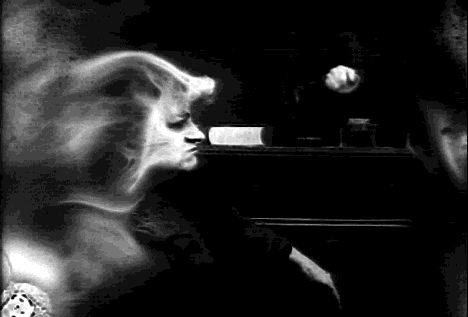
Decasia (2002) is the astounding epilogue to Peter Jackson’s The Return of the King. Where the Lord of the Rings films adhere to traditional narrative structures, albeit highly reliant on extreme crosscutting and hallucinatory imagery, Decasia flips the script of the One Ring by telling it through the venomous eye and “head” of Tolkien’s main antagonist Sauron, and by using a decidedly manic visual language. The film fills in psychological gaps that Jackson didn’t have the time or inclination to include. We see how Sauron saw Middle-earth, its inhabitants and the participants in the Fellowship that finally defeated him. From the way the film cuts back and forth between everyday occurrences and various plot points of the trilogy, it is made clear by the director Bill Morrison that Sauron’s inability to interpret or even discern between significant and insignificant events played a large part in his eventual downfall. We are given a Sauron suffering from juvenile paranoia and attention deficit. In one sequence he becomes fascinated with someone (is it Pippin?) climbing a ladder but gets distracted by an orc disturbing an anthill. While the ring is snuck into his kingdom he’s ecstatically transfixed by the streets of Minas Tirith, men running, houses collapsing from fire. He has prophetic visions of eagles circling in the skies and Mount Doom erupting but fails to piece them together, although his desperation to do so is evident. Morrison’s manipulation of the film stock shows his character’s seemingly omniscient ability to travel great distances tragically limited by headaches and partial blackouts, obscured by scratches, splotches, and wiggly amoebas; his vision routinely clouds over, erodes, blurs, wavers, pulsates. This is one pissed-off motherfucker who needs Lasik surgery in a bad way.
Decasia points out a failing of Jackson’s films: evil in LOTR is as beautifully composed and presented as good. Shouldn’t the very look of Sauron or his Black Riders into the camera warp the picture like salt water taffy or burn holes in the celluloid? Wouldn’t the eyes of necromancers, ghosts and zombies view the world as if inverted and filtered in Photoshop? What if instead of Howard Shore’s nice hummable tunes (with subtle darker passages mind you) we got Michael Gordon’s more psychologically appropriate symphony rising to a crescendo with guitar feedback reminiscent of Mogwai or My Bloody Valentine?
